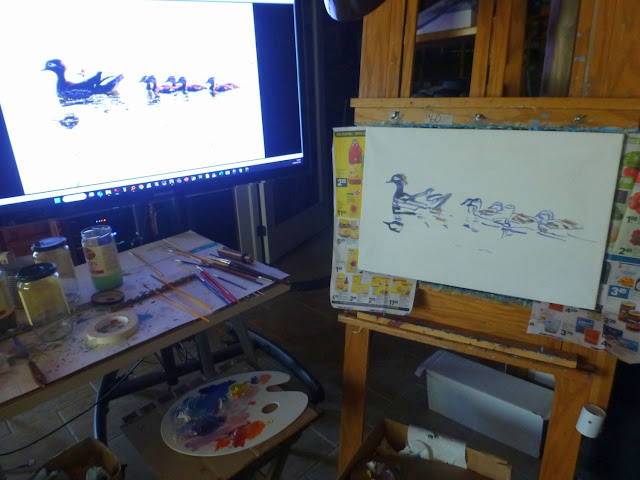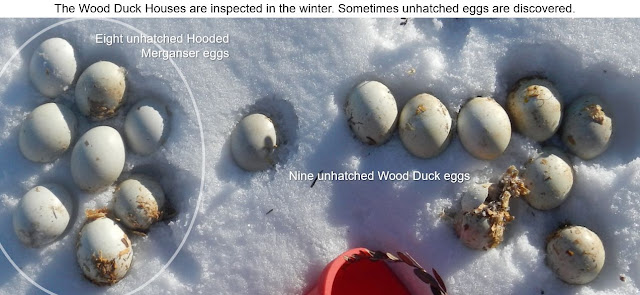 |
| #2960 "Brooding Wood Ducks" 16 x 24 by 3/4 depth stretched canvas (inches) Started 10:30 am Saturday, July 12th, 2025 |
This is another image taken by my friend, John Verburg, a naturalist and terrific photographer. John provides a tremendous source of inspiration that encourages me to paint within the Singleton Studio when conditions outside are not conducive to plein air. It was very hot and humid outside, so I was in the cooler environment of the Singleton Studio. Environment Canada had issued the appropriate advisories.
The first strokes of the sketch define how the painting might proceed. The image carried a wonderful story. The first marks of the brush on the virgin canvas just felt "right". It was going to be a good day.
Wood Duck broods like this are frequently seen during the summer. The ducklings crowd together so close to the mother hen that they look like a single, very long-bodied duck crossing the lake.
 |
| The first strokes on #2960 "Brooding Wood Ducks" ... went very well indeed. |
Wood Duck broods like this are frequently seen during the summer. The ducklings crowd together so close to the mother hen that they look like a single, very long-bodied duck crossing the lake.
Sometimes they parade across our lawn of red and white clover. Wood Ducks, like every other creature, are welcome at Singleton. This hen had nine ducklings behind her. The one at the end of the line was easily distracted. I know that feeling.
Wood Ducks cannot make their own cavities. There are about twenty Wood Duck boxes within the Singleton Sanctuary. They are very well used. The following map and images tell that story. The Wood Duck nesting boxes are numbered and monitored every year. Sometimes, hooded merganser eggs are also found in the boxes.
 |
| Ducks Unlimited Project at Singleton circa 2010 |
Breeding pairs search for those special nesting cavities during the early morning. The male waits outside as the female enters and examines the site. They (meaning "she") typically choose a large tree, often 2 feet in diameter, with a cavity located anywhere from 2 to 60 feet above ground level. The Wood Ducks prefer the higher cavities, which are typically places where a branch has broken off and the tree's heartwood has subsequently rotted. Woodpecker cavities are used less frequently. The nest tree is normally situated near or over water. Wood Ducks will use cavities up to a mile from water if nothing else is available.
 |
| Incubation Period: 28-37 days Nestling Period: 56-70 days |
After hatching, Wood Duck ducklings make a dramatic leap of faith from the nest to the ground, often falling from heights of over 50 feet to the ground below. The wood duck boxes at Singleton are about 12 feet off the ground with a predator guard to protect each nest.
While many migrate south for the winter, including the Singleton wood ducks, some Wood Ducks remain in southern Ontario during the colder months.
 |
| #2960 "Brooding Wood Ducks" Nearing completion in the Singleton Studio |
Wood Ducks feed by dabbling or short, shallow dives. They are strong fliers and can reach speeds of 30 mph. Wood Ducks are not territorial, with the exception that a male may fight off other males that approach his mate too closely. Courting males swim before a female with wings and tail elevated, sometimes tilting the head backwards for a few seconds. Males may also perform ritualized drinking, preening, and shaking movements. Both members of a pair may preen each other.
Wood Duck populations have increased since 1966, according to the North American Breeding Bird Survey. Partners in Flight estimates the global breeding population at 4.6 million and rates them 7 out of 20 on the Continental Concern Score, indicating a species of low conservation concern. This is good news, considering their dramatic declines from hunting in the late 19th century. Even so, Wood Ducks are second only to Mallards in the number of ducks shot by hunters every year.
For this and much more art, click on Pixels or go straight to the Collections. Here is the new Wet Paint 2024 Collection.
Warmest regards and keep your paddle in the water,
Phil Chadwick








No comments:
Post a Comment